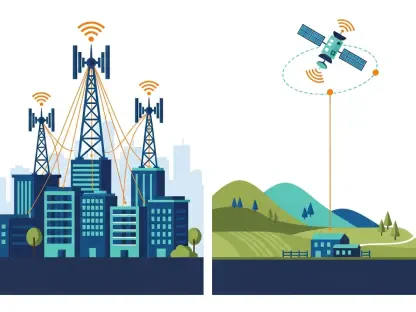The open Radio Access Network (open RAN) initiative launched with the ambitious goal of revolutionizing the telecommunications industry by creating standardized interfaces to foster competition and interoperability among various vendors. Initially hailed as a groundbreaking approach that could democratize the market and instigate a more level playing field, the reality seven years later paints a starkly different picture. Open RAN’s journey has been marked by skepticism and formidable challenges, as the telecom landscape continues to be predominantly controlled by a few established giants, leaving the initiative’s lofty aims largely unmet.
The Vision and Reality of Open RAN
Open RAN was conceived to break down the monopolistic practices in the telecom market by enabling a diverse range of vendors to contribute to network infrastructures. The proposition was to make the telecom sector more dynamic and competitive. However, contrary to these noble aspirations, the current market data showcases a significant concentration of power among a few dominant players. Reports from 2023 revealed that industry stalwarts like Huawei, Ericsson, Nokia, ZTE, and Samsung commanded an overwhelming 95.1% of global RAN sales. Particularly, Huawei, Ericsson, and Nokia alone captured more than three-quarters of the total market share, which poses an insurmountable barrier for smaller entities wishing to penetrate this market.
While open RAN supporters envisioned a landscape teeming with multiple vendors collaborating seamlessly, the reality has largely been one where the entrenched major companies maintain their stronghold. This continued dominance not only stifles innovations from smaller players but also diminishes the competitive edge that open RAN was supposed to bring. Despite their efforts, new entrants struggle to gain the necessary traction to challenge these heavyweights, effectively stalling the transformative momentum open RAN set out to achieve.
Economic and Commercial Challenges
The economic and commercial dynamics of the RAN sector also contribute to the limitations faced by new entrants. With no significant growth in the RAN sector, any market share garnered by smaller players would directly impinge on the portions of established giants like Ericsson and Nokia. This zero-sum game makes it exceedingly difficult for new vendors to find a foothold. Compounding the challenge is the substantial R&D investment demanded to develop top-tier 5G products, which can amount to billions annually. This high barrier to entry severely restricts smaller vendors who lack such financial prowess.
Moreover, there is a distinct disconnect between the idealistic objectives of open RAN and the harsh market realities. Despite adopting open standards, telecom operators continue to rely heavily on established major vendors. This phenomenon, referred to as “single vendor open RAN,” highlights that the adherence to open standards has not significantly shifted the procurement behaviors of telecom operators. The aversion to risk and preference for proven, reliable solutions outweigh the benefits of an interoperable multi-vendor environment, leaving smaller players at a considerable disadvantage.
The Role of Major Telecom Operators
Among the major advocates for open RAN, Orange stands out for its vocal support. Laurent Leboucher, the group chief technology officer at Orange, has candidly addressed the ongoing challenges in achieving open RAN’s transformative vision. While he acknowledges that niche opportunities do exist for smaller vendors, particularly in areas such as indoor coverage and neutral host environments, he concedes that the broader objective of supplanting traditional mobile networks with open RAN solutions has proven elusive.
Leboucher sees a potential path forward in leveraging the strengths of leading vendors like Ericsson and Nokia to overcome technical obstacles, such as those posed by massive MIMO (Multiple Input Multiple Output) technology, which is vital for enhancing 5G performance. Massive MIMO involves complex Layer 1 functionalities that have yet to be fully standardized under open RAN specifications. The lack of standardization adds another layer of difficulty in supporting an open and interoperable vendor ecosystem.
The Complexity of Collaboration
Efforts to foster collaboration between major vendors like Ericsson and Nokia are fraught with complications stemming from their inherent rivalry. Both companies have shown some willingness to work with smaller vendors, yet the prospect of extending this cooperation to each other remains uncertain. This hesitation raises questions about the viability of creating an effective open RAN ecosystem that relies on such high-profile partnerships.
Ultimately, the success of these collaborative initiatives depends heavily on the willingness of major vendors to pool their expertise and resources. Telecom operators can encourage and advocate for these integrations, but the ultimate decision rests with the vendors themselves. The competitive nature of the telecom industry and the strategic interests of these significant players may hinder meaningful collaboration, further delaying open RAN’s path to widespread adoption.
Historical Context and Geopolitical Factors
The impetus behind the open RAN movement can be traced to several critical factors, including concerns over vendor consolidation and geopolitical tensions with Chinese vendors like Huawei and ZTE. These concerns spurred a reevaluation of the network equipment market and an effort to rejuvenate competition. Notably, various geopolitical strategies have led to restrictive policies on Chinese solutions, prompting operators to explore alternatives. This shift has allowed non-Chinese vendors like Nokia and Samsung to improve their market positions.
In recent years, Nokia’s products have seen significant improvements, and Samsung has emerged as a credible alternative in the RAN vendor space. These developments have been welcomed by operators, particularly in regions where political considerations limit the deployment of Chinese equipment. Nevertheless, this diversification, though positive, has not translated into the broad market democratization envisioned by open RAN proponents. Major global vendors continue to dominate the market, stifling the entrance and growth of newer competitors.
The Road Ahead for Open RAN
The open Radio Access Network (open RAN) initiative began with the bold aim of transforming the telecommunications sector by developing standardized interfaces to encourage competition and interoperability among different vendors. Initially celebrated as a revolutionary strategy that could democratize the market and establish a fairer field, the situation seven years later presents a very different story. The journey of open RAN has been fraught with skepticism and significant challenges. Despite its high ambitions, the telecom landscape continues to be dominated by a few major players, leaving the initiative’s lofty goals largely unachieved. Open RAN’s struggle illustrates the difficulty of disrupting an industry so heavily controlled by established giants, bringing into question whether its initial promise can ever be fully realized. The hurdles faced by open RAN reflect the complex dynamics of the telecom market, where innovation must continually grapple with entrenched interests and market power.









